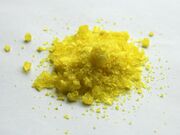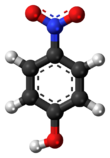Chemistry:4-Nitrophenol
| |||

| |||
| Names | |||
|---|---|---|---|
| Preferred IUPAC name
4-Nitrophenol | |||
| Other names | |||
| Identifiers | |||
3D model (JSmol)
|
|||
| ChEBI | |||
| ChEMBL | |||
| ChemSpider | |||
| DrugBank | |||
| KEGG | |||
PubChem CID
|
|||
| UNII | |||
| |||
| |||
| Properties | |||
| C6H5NO3 | |||
| Molar mass | 139.110 g·mol−1 | ||
| Appearance | Colourless to pale yellow crystals | ||
| Melting point | 113 to 114 °C (235 to 237 °F; 386 to 387 K) | ||
| Boiling point | 279 °C (534 °F; 552 K) | ||
| 10 g/L (15 °C) 11.6 g/L (20 °C) 16 g/L (25 °C) | |||
| Acidity (pKa) | 7.15 (in water), | ||
| -69.5·10−6 cm3/mol | |||
Except where otherwise noted, data are given for materials in their standard state (at 25 °C [77 °F], 100 kPa). | |||
| Infobox references | |||
4-Nitrophenol (also called p-nitrophenol or 4-hydroxynitrobenzene) is a phenolic compound that has a nitro group at the opposite position of the hydroxyl group on the benzene ring.
Properties
4-Nitrophenol shows two polymorphs in the crystalline state. The alpha-form is colorless pillars, unstable at room temperature, and stable toward sunlight. The beta-form is yellow pillars, stable at room temperature, and gradually turns red upon irradiation of sunlight. Usually 4-nitrophenol exists as a mixture of these two forms.
In solution, 4-nitrophenol has a dissociation constant (pKa) of 7.15 at 25 °C.[2]
Preparation
From phenol
4-Nitrophenol can be prepared by nitration of phenol using dilute nitric acid at room temperature. The reaction produces a mixture of 2-nitrophenol and 4-nitrophenol.
Uses
pH indicator
| 4-Nitrophenol (pH indicator) | ||
| below pH 5.4 | above pH 7.5 | |
| 5.4 | ⇌ | 7.5 |
4-Nitrophenol can be used as a pH indicator. A solution of 4-nitrophenol appears colorless below pH 5.4 and yellow above pH 7.5.[3] This color-changing property makes this compound useful as a pH indicator. The yellow color of the 4-nitrophenolate form (or 4-nitrophenoxide) is due to a maximum of absorbance at 405 nm (ε = 18.3 to 18.4 mM−1 cm−1 in strong alkali).[4] In contrast, 4-nitrophenol has a weak absorbance at 405 nm (ε = 0.2 mM−1 cm−1).[4] The isosbestic point for 4-nitrophenol/4-nitrophenoxide is at 348 nm, with ε = 5.4 mM−1 cm−1.[5]
Other uses
- 4-Nitrophenol is an intermediate in the synthesis of paracetamol. It is reduced to 4-aminophenol, then acetylated with acetic anhydride.[6]
- 4-Nitrophenol is used as the precursor for the preparation of phenetidine and acetophenetidine, indicators, and raw materials for fungicides. Bioaccumulation of this compound rarely occurs.
- In peptide synthesis, carboxylate ester derivatives of 4-nitrophenol may serve as activated components for construction of amide moieties.
Uses of derivatives
In the laboratory, it is used to detect the presence of alkaline phosphatase activity by hydrolysis of PNPP. In basic conditions, presence of hydrolytic enzymes will turn reaction vessel yellow.[7]
4-Nitrophenol is a product of the enzymatic cleavage of several synthetic substrates such as 4-nitrophenyl phosphate (used as a substrate for alkaline phosphatase), 4-nitrophenyl acetate (for carbonic anhydrase), 4-nitrophenyl-β-D-glucopyranoside and other sugar derivatives which are used to assay various glycosidase enzymes. Amounts of 4-nitrophenol produced by a particular enzyme in the presence of its corresponding substrate can be measured with a spectrophotometer at or around 405 nm and used as a proxy measurement for the amount of the enzyme activity in the sample.
Accurate measurement of enzyme activity requires that the 4-nitrophenol product is fully deprotonated, existing as 4-nitrophenolate, given the weak absorbance of 4-nitrophenol at 405 nm. Complete ionization of the alcohol functional group affects the conjugation of the pi bonds on the compound. A lone pair from the oxygen can be delocalized via conjugation to the benzene ring and nitro group. Since the length of conjugated systems affects the color of organic compounds, this ionization change causes the 4-nitrophenol to turn yellow when fully deprotonated and existing as 4-nitrophenolate.[8]
A common mistake in measuring enzyme activity using these substrates is to perform the assays at neutral or acidic pH without considering that only part of the chromophoric product is ionized. The problem can be overcome by stopping the reaction with sodium hydroxide (NaOH) or other strong base, which converts all product into 4-nitrophenoxide; final pH must be > ca. 9.2 to ensure more than 99% of the product is ionised. Alternatively enzyme activity can be measured at 348 nm, the isosbestic point for 4-nitrophenol/4-nitrophenoxide.
Toxicity
4-Nitrophenol irritates the eyes, skin, and respiratory tract.[9] It may also cause inflammation of those parts. It has a delayed interaction with blood and forms methaemoglobin which is responsible for methemoglobinemia, potentially causing cyanosis, confusion, and unconsciousness.[9] When ingested, it causes abdominal pain and vomiting. Prolonged contact with skin may cause allergic response. Genotoxicity and carcinogenicity of 4-nitrophenol are not known. The -1">50 in mice is 282 mg/kg and in rats is 202 mg/kg (p.o.).
See also
- Nitrophenols
References
- ↑ This is no longer a recommended IUPAC name: Nomenclature of Organic Chemistry : IUPAC Recommendations and Preferred Names 2013 (Blue Book). Cambridge: The Royal Society of Chemistry. 2014. p. 690. doi:10.1039/9781849733069-FP001. ISBN 978-0-85404-182-4. "Only one name is retained, phenol, for C6H5-OH, both as a preferred name and for general nomenclature. The structure is substitutable at any position. Locants 2, 3, and 4 are recommended, not o, m, and p."
- ↑ "TOXNET". https://toxnet.nlm.nih.gov/cgi-bin/sis/search/r?dbs+hsdb:@term+@rn+@rel+100-02-7.
- ↑ "4-Nitrophenol CAS 100-02-7 | 106798". http://www.merckmillipore.com/INTL/en/product/4-Nitrophenol,MDA_CHEM-106798.
- ↑ 4.0 4.1 Bowers, G.N.; McComb, R.B.; Christensen, R.C.; Schaffer, R. (1980). "High-Purity 4-Nitrophenol: Purification, Characterization, and Specifications for Use as a Spectrophotometric Reference Material". Clinical Chemistry 26 (6): 724–729. doi:10.1093/clinchem/26.6.724. PMID 7371150. http://www.clinchem.org/clinchem/article/26/6/724/5664415.
- ↑ Biggs, A.I. (1954). "A spectrophotometric determination of the dissociation constants of p-nitrophenol and papaverine". Transactions of the Faraday Society 50 (50): 800–802. doi:10.1039/tf9545000800.
- ↑ Ellis, Frank (2002). Paracetamol: a curriculum resource. Cambridge: Royal Society of Chemistry. ISBN 0-85404-375-6.
- ↑ Ninfa, Alexander (2010). Fundamental Laboratory Approached for Biochemistry and Biotechnology. Wiley. pp. 153, 243. ISBN 978-0470087664.
- ↑ "The Relationship Between UV-VIS Absorption and Structure of Organic Compounds". http://www.shimadzu.com/an/uv/support/uv/ap/apl.html.
- ↑ 9.0 9.1 Toxicological Profile For Nitrophenols (Report). Agency for Toxic Substances and Disease Registry, U.S. Public Health Service. July 1992. http://www.atsdr.cdc.gov/toxprofiles/tp50.pdf.
 |




